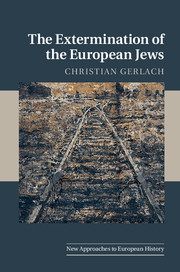Book contents
- Frontmatter
- Contents
- List of tables
- Acknowledgments
- List of abbreviations
- 1 Introduction
- Part I Persecution by Germans
- Part II Logics of persecution
- Part III The European dimension
- 12 Legislation against Jews in Europe: A comparison
- 13 Divided societies: Popular input to the persecution of Jews
- 14 Beyond legislation: Non-German policies of violence
- 15 In the labyrinths of persecution: Survival attempts
- 16 Conclusion: Group destruction in extremely violent societies
- Bibliography
- Index
14 - Beyond legislation: Non-German policies of violence
from Part III - The European dimension
Published online by Cambridge University Press: 05 March 2016
- Frontmatter
- Contents
- List of tables
- Acknowledgments
- List of abbreviations
- 1 Introduction
- Part I Persecution by Germans
- Part II Logics of persecution
- Part III The European dimension
- 12 Legislation against Jews in Europe: A comparison
- 13 Divided societies: Popular input to the persecution of Jews
- 14 Beyond legislation: Non-German policies of violence
- 15 In the labyrinths of persecution: Survival attempts
- 16 Conclusion: Group destruction in extremely violent societies
- Bibliography
- Index
Summary
In many countries, the persecution of Jews did not stop at legal measures. However, the intensity of anti-Jewish violence differed widely. Three countries conducted mass murders of Jews. In several waves (the worst of which was in 1942), about three-quarters of the 40,000 Jews in the state of Croatia were either massacred by their compatriots or, to a lesser extent, deported to German-run death camps. Most of the rest survived underground; a few thousand belonged to government-protected groups. In 1941–42, largely, Romanians killed or let die at least 250,000 Jews, primarily those deported from Bessarabia and Bukovina to Transnistria and local Soviet Jews from occupied Transnistria, but the Romanian government refused to surrender as many Jews from the Old Kingdom to Germany, and they survived the war. For some time, the Hungarian government refused to allow Jews to be deported to Germany until the German invasion in March 1944, when the Sztójay government cooperated closely in the deportation of more than 400,000 Jews to Germany, and the Arrow Cross regime handed over another 76,000. About 250,000 Jews from Greater Hungary survived, half inside the country in the Budapest ghettos and the forced labor service, and the other half in German camps. Hungarian authorities deported at least 16,000 Jews without Hungarian citizenship to the former Soviet territories of Galicia and Volyn in the summer of 1941, whereupon German and Hungarian forces soon shot them; more than 20,000 Jews may have died in the army's Labor Battalions between 1942 and 1943, and Arrow Cross squads killed many thousands in Budapest in late 1944.
Other governments which did not themselves organize the mass destruction of Jews did, however, acquiesce to it; some (like Slovakia) even offered to deport their Jews to Germany, or (as was the case in Hungary and Bulgaria) sometimes urged Germany to deport Jews more quickly. Non-German police or gendarmerie often made arrests. In this way, 80% of the Slovakian Jews were deported in 1942, and most of them killed, while the rest were kept in Slovakia as forced laborers – although many of these were killed in the wake of the Slovakian national uprising in August and September 1944. The fascist Norwegian government had about half of the country's approximately 2,000 Jewish inhabitants (all they could lay hands on) deported in 1942; the rest escaped to Sweden.
- Type
- Chapter
- Information
- The Extermination of the European Jews , pp. 368 - 403Publisher: Cambridge University PressPrint publication year: 2016



